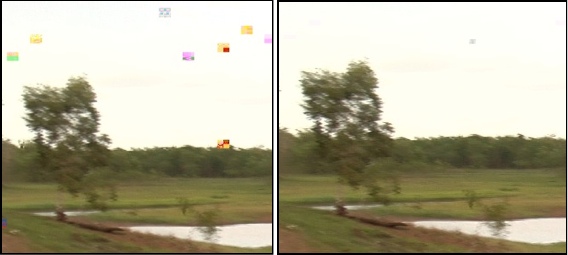Expectations
(First instalment of my “Movie Repair Guide” serie)
Not all repairs can be equally successful at restoring original quality and integrity of footage.
It’s due to three factors:
- a. initial state of data
- b. redundancy of data
- c. ability of the repairman

a. initial state of data
The worse case is a file that even if it keeps the correct movie name and size, no longer contains data related to the movie.
It can either be “alien data”, random data, and it can affect a part or the whole file.
It’s clear that no repair is possible here. I don’t do miracles and I will just tell you that it cannot be repaired (free of charge, of course!)
The best case is a file that contains all the media data, cleanly arranged in frames, but that fails to open because some small detail is not correct. If you correct this detail, the file is repaired at original quality. This detail is usually the structure of the container and the index of the media inside the file.
In the middle, you find files that still contain 50% to 99% of the media data, but it’s completely mixed and disorganized. Furthermore, the file can contain some quantity of alien data. Those files usually come from a failure in the file/operating system or in the storage device (Hard disk, memory cards, …). Even with the best repair skills at work, one cannot expect in this case to recover the entire movie at original quality. The cost of such a repair will be much higher than a “best case” repair, because the techniques involved are more complex and need customization to each case, and even if the results is far from “broadcast quality”.
Finally, initial state of data can be misjudged when the repair is developed on a sample of the file. The sample can be clean, but on average the whole file can contain several “hot spots”, pattern breaks and segments full of alien data. This can lead to an increase between quotation given after diagnostic and final cost.
b. Redundancy of data
A rule of the thumb is that the more advanced codecs you use, the more efficient compression you get. But at the same time, the repair becomes more difficult.
The reason is that efficient compression leaves few hints to do a repair, as efficiency means no information “wasted” to make encoding redundant and movie structure easy to read. The extreme case would be a codec so efficient that the bitstream looks like random data, and that any random bitstream is decoded as valid.
AAC audio codec, for example, is quite close to this situation.
Identifying an audio or video frame in such cases is really challenging, and a certain failure rate is to be expected. If you have 5% failure rate repairing AAC, the result is barely audible. At 0.5% you have something decent, but not broadcast quality.
On the other hand, in codecs like DV, the failure rate is 0 because more than 1% of the data is predictable and redundant, so mistake is impossible.
c. Ability of the repairman
An experienced video hacker with the right set of tools: That’s what I’m trying to become. If you are able to detect the subtle data patterns inside the damaged file, you have the key for a quality repair.
Below, you see the same movie frame repaired by an experienced hacker (on the left) and by an inspired hacker (on the right, also me ;). This was a very tough repair, because we were on the bad case for initial state of data. This explains why a traditional repair leaves a lot of artifacts on the picture. But after more work, I discovered a more advanced technique, called de-spotting, that eliminates almost all the defects by trial and error. It takes a lot of computing time for each frame, but it cleans almost everything.

I try to give the right expectations to my customers. Difficult repairs can be more expensive and yet achieve only bad video quality. That’s a tough business.

